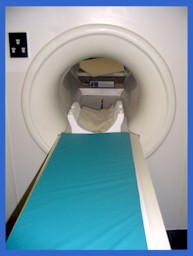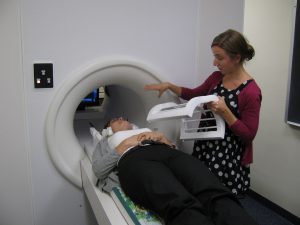General information
Research in the CDN Lab explores the development and neurobiological correlates of cognitive development, particularly learning, memory, and attention during infancy through adolescence. Our laboratory employs several approaches to studying brain-behavior relations, including behavioral research and structural and functional magnetic resonance imaging (MRI).
Equipment/facilities

Our laboratory is equipped with a 128 channel EGI netstation and a SMI Eye Tracking System. We also have shared use of 3.0 Tesla Siemens research scanners located at the Center for Magnetic Resonance Imaging and the Masonic Institute for the Developing Brain, which are equipped with IFIS stimulus presentation and response collection devices for functional MRI studies.
Additionally, we utilize a MRI simulator to acclimate children and adults to the scanning environment; this simulator is equipped with an integrated functional imaging system (IFIS) for stimulus display and response recording.
Ongoing projects
Hot Executive Function Skills in Preschool-Aged Children (PHEF)
The purpose of this study is to look at executive function in preschool-aged children. Executive function refers to the brain processes that control goal-oriented activities, such as attention, planning, and self-control. There is evidence of difficulties with executive function in children who were born extremely preterm or extremely low birth weight. Delayed or atypical development of executive function has been demonstrated in the extremely preterm population when they reach childhood. The current study explores whether children who were born less preterm also have differences in executive function. Children born moderate-to-late preterm often have difficulties in the newborn period that resolve prior to newborn hospital discharge. However, some of these problems have the potential to have a lasting impact on the developing brain. Our goal is to examine how children born moderate-to-late preterm perform on executive function tasks that involve a motivational or emotional context compared to their full-term peers.
Memory and Motivation in Preschool-Aged Children (MEMO)
The MEMO study is a cross-sectional study of memory and motivation in preschool children born moderately preterm. There is research suggesting that different motivational contexts make a difference in how children born moderately preterm perform on high level cognitive tasks such as executive function tasks compared to their full-term peers. We also know that regions involved in memory, such as the hippocampus, are highly affected by a premature birth. Our primary aim is to examine whether low-risk healthy children born moderate-to-late preterm exhibit impairments in the development of memory skills, especially memory in the context of different motivation and reward contexts. This study will use different memory and cognitive tasks to understand the intersection between memory skills and motivation in preschool children born moderately preterm.
Minnesota Imaging Stress Test in Children (MISTiC)
Responding effectively to stressful situations relies upon a diverse set of individual resources, including recruitment of the neuroendocrine system. One component of this system, the HPA-axis contributes to the body’s response to stress via the secretion of the hormone cortisol. Many studies have investigated changes in cortisol levels when children and adolescents complete stressful situations, like delivering a speech and doing math problems in front of judges.

To date, however, little is known about how these responses interact with brain activity. This study uses magnetic resonance imaging (MRI) and concurrent salivary cortisol sampling to investigate neuroendocrine responses to psychosocial stress. Further, a number of self- and parent-report measures will be used to investigate the associations between individual differences such as self-esteem and the strength of caregiving relationships and the stress response.
Emotion Regulation in the Transition to Adolescence (ERT)
The primary aim of this cross-sectional study is to understand emotion regulation during the transition into adolescence. In particular, we are assessing whether and how the presence of a mother facilitates the regulation of negative emotion during this age range. Children have been shown to benefit from maternal presence prior to adolescence in both stress and emotion regulation, but mothers are not effective stress buffers in adolescence. The current study uses event-related potentials (ERP) to capture a neural indicator of regulation efficacy. Temporal accuracy in the ERP method allows us to differentiate between immediate emotional reaction and later emotion regulation. Self-report measures of emotional support and coaching in the home will be used to determine whether parenting practices around emotions have an impact on how effectively teens are able to self-regulate. Data collection on this project is currently paused.

